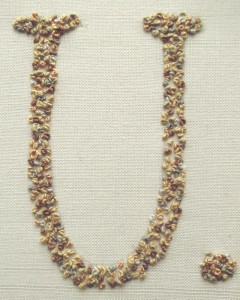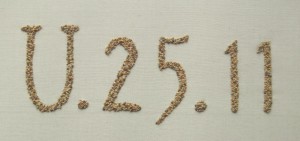Stitching “Typed on Camelback in a Sandstorm”
The whole idea of this patch is to recall an incident that Mary Chubb describes, in which sand adhered to a freshly-typed page, creating “a rather pretty embossed effect”. In the end, I chose the grid reference of the Expedition House, where the team lived during the digging season.
I used a selection of silk threads from Mulberry Silks, from a colour family called “Old Cotswold”, which I’ve also used for the panel showing the Crock of Gold Hoard. It included a russet, a mid-grey and a very pale greyish-white as well as several sandy colours.
I used all of the colours this time, and discovered that the threads are not all the same, some being finer than others. That’s perfect in this case – some of the grains of sand would be finer than others, and I could accentuate or reduce the differences by using more or fewer wraps in my French Knots. I think it looks really very sandy indeed!
It took a remarkably short period of time. And what’s more, considering that I’m not really a fan of French Knots (I never could get the hang of them when I began embroidering), I rather enjoyed it. Although I must admit, it was beginning to get quite tricky, what with all those layers of thread. I swapped over to a sharp needle and even that was a struggle!
Still, that’s another piece completed…
And, as a bonus – an animation. This was put together by Simon Walters (@cymplecy on Twitter), using some photos I provided. I’m impressed with what he produced, considering that I didn’t take the pictures in a very controlled environment, and it will give you some idea of the view I had as I built up the effect, colour by colour
Thank you, Simon!




Very nice! I’m not a fan of french knots either, but I love the effects this gives.
I quite enjoy French knots – I use an extra sort of tacking stitch to keep them in pace, is that allowed !?!?
An excellent animation – whilst admiring your work, I was also thinking of Tony Hart!
I enjoyed watching the lettering come alive on the video.
I sometimes use a second tack when I am doing a single, large FK on things like counted work when the exact placing matters a lot. I like using them in mass, scrunched together for a filling, to make a textured surface – especially with blended/variegated colours. (They don’t need an extra tack in that case.)
When I worked at The Needlewoman Shop, I once had to try to explain French knots over the telephone to a bewildered customer. That was a challenge! I never did find out if she made sense of my explanation – I rather doubt it.
Really love the effect and the colours – and the .gif is just fab – well done Simon!
French knots are one of those stitches that just takes practice and good tension. I’m sure with a bit more practice you won’t struggle so much.
don’t you just love Mulberry silks colour packs? and you have used them with brilliant effect here…
Absolutely lovely and so ‘authentic’ looking. I love French Knots — they are definitely a stitch where you have to ‘be in the moment’ since the the work is so small and the correct tension so needed. Yours are gorgeous.
I agree. It looks very sandy indeed! I do love French knots!
It really looks great!
Rachel, the french knot and the color really lovely. I got inspiration from your stitches. I love your artistic embroidery. The french knots are easy for me to follow. As you noted I like to do the knots on my book cover. Really love the textures with only a few “twists”. Love all your works.
You have really captured the texture of sand. The colour choices make it look gritty. great result.
I couldn’t leave a comment on the amazing post you linked to the Stitchery Linky, so I came to see what you are doing now. Equally amazing! I love what you did, and the animation is great, so thanks for sharing that.
Looks great! Lovely colors.. It definitely looks sandy…well done Rachel!